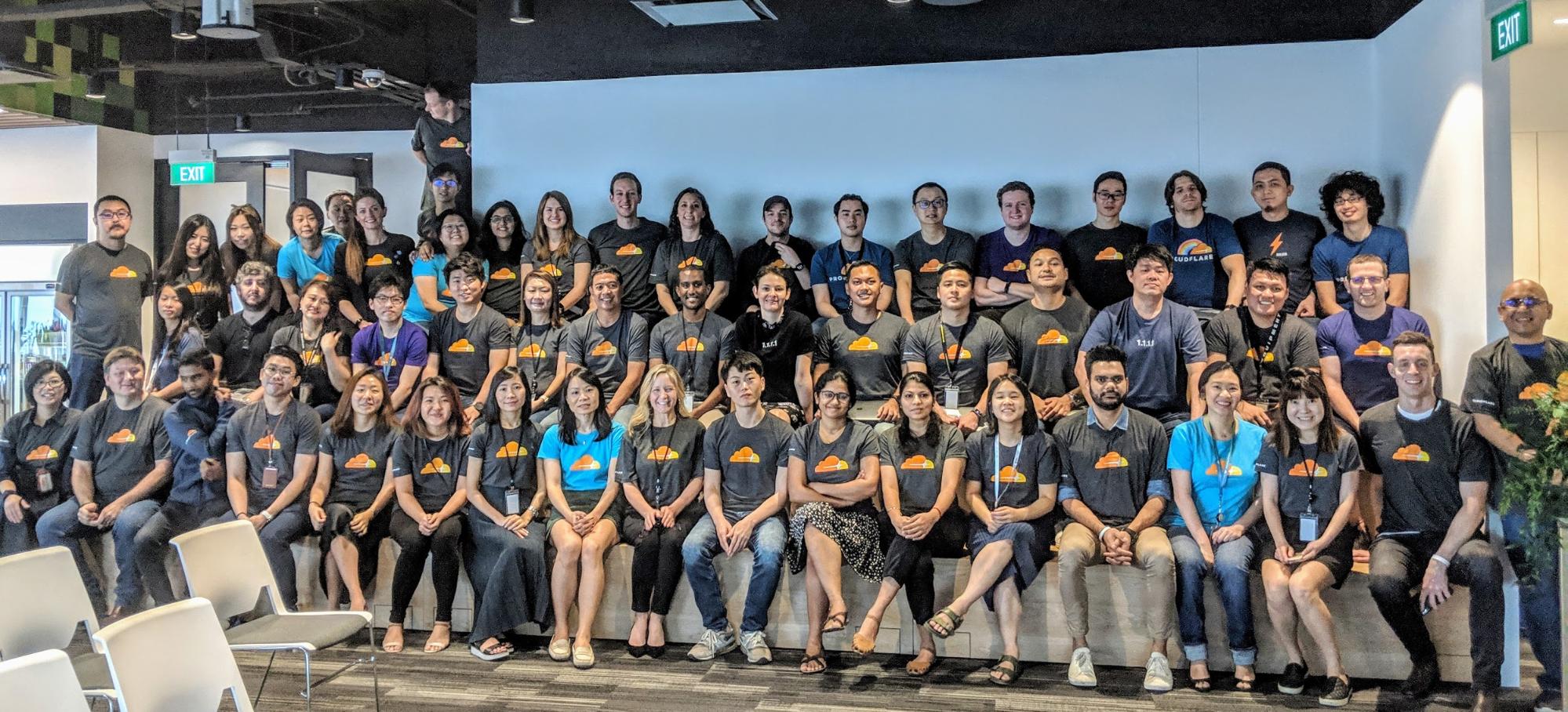CloudFlare Raises $150M, Likely Delaying Its Expected IPO
 This round brings CloudFlare’s total funding to $330 million. Its investors include CapitalG...
This round brings CloudFlare’s total funding to $330 million. Its investors include CapitalG...
 This round brings CloudFlare’s total funding to $330 million. Its investors include CapitalG...
This round brings CloudFlare’s total funding to $330 million. Its investors include CapitalG...
 The ability to put core network functions on software so AT&T can control, improve, and...
The ability to put core network functions on software so AT&T can control, improve, and...

One year into my role as Head of Asia for Cloudflare, I wanted to reflect on what we’ve achieved, as well as where we are going next.
When I started, I spoke about growing our brand recognition in Asia and optimizing our reach to clients by building up teams and channel partners. I also mentioned a key reason behind my joining was Cloudflare’s mission to help build a better Internet and focus on democratizing Internet tools that were once only available to large companies. I’m delighted to share that we’ve made great progress and are in a strong position to continue our rapid growth. It’s been a wonderful year, and I’m thrilled that I joined the company.
There has been a lot going on in our business, as well as in the region. Let’s start with Cloudflare Asia.
Our Singapore team has swelled from 40 people from 11 countries to almost 100 people from 19 nations. Our team is as diverse as our client base and keeps the office lively and innovative.

The number of Asian businesses choosing to work with us has more than doubled. You can check out what Continue reading

For more than a decade, different organizations from civil society and the private sector have been involved in efforts to establish an Internet Exchange Point (IXP) in the Dominican Republic, with no success. Possible causes were either lack of interest at the time, the maturity level of the ICT sector, or even lack of financial support. The Internet Society Dominican Republic Chapter decided to discuss those outcomes with different stakeholders and promote an atmosphere to proceed when the moment was right.
Among efforts from the past, it is important to mention two of them, which made important advances: (1) the datacenter firm NAP del Caribe (NDC), invited interested local Internet Service Providers (ISP) to establish either an IXP or private peering; (2) the academic sector worked to establish a local research network, Red de Avanzada Dominicana de Estudio e Investigación (RADEI), which sought the support of the local regulator Instituto Dominicano de las Telecomunicaciones (INDOTEL).
In 2017, the Internet Society Chapter Dominican Republic (ISOC-DO) board, after considering past efforts and brainstorming on different approaches to succeed in the IXDO initiative, taking inspiration on the regional trends, and locating experts to support our goal, decided to design the annual Continue reading

F5 get service mesh, buys a competitor, get open source chops, but still behind on cloud'iness.
The post Analysis: F5 Networks Buys NGINX. Six Good Reasons and the rest. appeared first on EtherealMind.
 The European Parliament calls for action at the EU level on security threats linked to China.
The European Parliament calls for action at the EU level on security threats linked to China.
Outro Music:
Danger Storm Kevin MacLeod (incompetech.com)
Licensed under Creative Commons: By Attribution 3.0 License
http://creativecommons.org/licenses/by/3.0/
The post History Of Networking – Cisco CLI – Terry Slattery and Rob Widmer appeared first on Network Collective.

With the release of the new 9200 series switches many enterprise organizations are starting to look towards the future. Cisco has also been looking towards the future… of their profit margin. With the 2960x platform is nearing it’s EOS/EOL announcement, Cisco has been working to promote the new hardware. And by now most Cisco enterprise customers have realized that DNA Center licensing is mandatory on your initial hardware purchase. This is certainly a deviation from Cisco’s normal à la carte licensing, but what do you think is the driving force behind all of this?
The era of SaaS and Subscription based licensing has been upon us for some time. Last year Gartner predicted, “By 2020, all new entrants and 80% of historical vendors will offer subscription-based business models”. These shifts to recurring-revenue models are the latest adaptation for companies like Cisco to continue to pad their bottom line with dollars their customers may not be ready to spend. After all, why would Cisco miss out on dollars left on the table?
When I started laying out the network hardware roadmap for the next 24-36 months, I quickly realized that costs for the Catalyst 9200 series will raise per port Continue reading
A European networking engineer sent me this question:
I'd like to know where other fellow engineers meet up especially in Europe and discuss Enterprise datacenter and regular networking. There are the Cisco Live stuff things to go to but are there any vendor neutral meetups?
Gabi Gerber is organizing networking-focused workshops in Switzerland every quarter (search under SIGS Workshops), and you’re most welcome to join us ;) It’s always a boutique event, but that gives us the ability to chat long into the evening.
Read more ...Cloud programming simplified: a Berkeley view on serverless computing Jonas et al., arXiv 2019
With thanks to Eoin Brazil who first pointed this paper out to me via Twitter….
Ten years ago Berkeley released the ‘Berkeley view of cloud computing’ paper, predicting that cloud use would accelerate. Today’s paper choice is billed as its logical successor: it predicts that the use of serverless computing will accelerate. More precisely:
… we predict that serverless computing will grow to dominate the future of cloud computing.
The acknowledgements thank reviewers from Google, Amazon, and Microsoft among others, so it’s reasonable to assume the major cloud providers have had at least some input to the views presented here. The discussion is quite high level, and at points it has the feel of a PR piece for Berkeley (there’s even a cute collective author email address: serverlessview at berkeley.edu), but there’s enough of interest in its 35 pages for us to get our teeth into…
The basic structure is as follows. First we get the obligatory attempt at defining serverless, together a discussion of why it matters. Then the authors look at some of the current limitations (cf. ‘Serverless Continue reading
At AWS re:Invent 2018 last November, AWS introduced a regional construct called Transit Gateway (TGW). AWS Transit Gateway allows customers to connect multiple Virtual Private Clouds (VPCs) together easily. TGW can be seen as a hub and all the VPCs can be seen as spokes in a hub and spoke-type model; any-to-any communication is made possible by traversing the TGW. TGW can replace the popular AWS Transit VPC design many customers have deployed prior for connecting multiple Virtual Private Clouds (VPCs) together. In this post, I will discuss TGW and how it can currently be used with VMware Cloud on AWS. At the end of this post there’s also a video you can watch of a demo using the same setup described in this blog; feel free to jump to the video if you like. Continue reading
Among the emerging themes for 2019 in the datacenter, one of them is that NVM-Express is finding its place in the storage hierarchy. …
NVM-Express Storage Goes Mainstream Over Ethernet Fabrics was written by Timothy Prickett Morgan at .

It is often argued that IPv4 practices should be forgotten when deploying IPv6, as after all IPv6 is a different protocol! But we think years of IPv4 operational experience should be leveraged as much as possible.
So we are publishing IPv6 Security for IPv4 Engineers as a roadmap to IPv6 security that is specifically aimed at IPv4 engineers and operators.
Rather than describing IPv6 in an isolated manner, it aims to re-use as much of the existing IPv4 knowledge and experience as possible, by highlighting the security issues that affect both protocols in the same manner, and those that are new or different for the IPv6 protocol suite. Additionally, it discusses the security implications arising from the co-existence of the IPv6 and IPv4 protocols.
Be sure also to check our IPv6 Security page as well!
Further Information
The post IPv6 Security for IPv4 Engineers appeared first on Internet Society.
In my 11 year career as an IT instructor, I’ve had to pass a lot of certification exams. In many cases not on the first try. Sometimes for fair reasons, and sometimes, it feels, for unfair reasons. Recently I had to take the venerable Cisco CCNA R&S exam again. For various reasons I’d allowed it to expire, and hadn’t taken many exams for a while. But recently I needed to re-certify with it which reminded me of the whole process.
Having taken so many exams (50+ in the past 11 years) I’ve developed some opinions on the style and content of exams.

In particular, I’ve identified some types of questions I utterly loath for their lack of aptitude measurement, uselessness, and overall jackassery. Plus, a couple of styles that I like.
This criticisms is for all certification exams, from various vendors, and not limited to even IT.
The question of the usefulness of certification is not new.
One one hand, you have a need to weed out the know-its from the know-it-nots, a way to effectively measure a person’s aptitude in a given subject. A certification exam, in its purest form, is meant to Continue reading

Asia Pacific Regional Internet Conference on Operational Technologies (APRICOT) 2019, said to be the largest technical conference in the region, drew hundreds of the world’s leading Internet engineers from over 50 countries to Daejeon, South Korea last week.
The Internet Society, a long-time partner of the event, contributed to the event by not only sponsoring over a dozen of fellows to travel there, but also made multiple high-profile appearances in various sessions, including the opening keynote speech.
The Internet Society’s President and CEO Andrew Sullivan delivered the keynote Up and Down the Stack Through a Nerd’s Eyes: Making the Internet Better the Internet Way with hundreds of people present, including Tae-Jeong Her, Mayor of Daejeon, and Dr Hee-yoon Choi, President of organiser the Korea Institute of Science and Technology Information (KISTI), a government research institute.
Now that so many people depend on the Internet, it is no surprise that businesspeople, policymakers, regulators, and politicians all want a say in the way the Internet evolves. But some of the proposals for the future of the Internet, Sullivan said, betray fundamental misunderstandings of the way the Internet works. The talk urged us all to continue to engage with the big questions Continue reading
Subscribe to Kernel of Truth on iTunes, Google Play, Spotify, Cast Box and Sticher!
Click here for our previous episode.
You asked for it, we listened, and now we’re delivering! This episode, host Brian calls on Pete Lumbis and special guest David Illes from Mellanox to answer a question we got on our community Slack channel: “What are middle-tier customers doing for storage of Cumulus enabled solutions?” David and Pete share not only what’s changing for middle-tier customers but also tackle the topic of storage solutions in general. What sort of things are we seeing as customers migrate to Ethernet storage? Listen and find out.
Guest Bios
Brian O’Sullivan: Brian currently heads Product Management for Cumulus Linux. For 15 or so years he’s held software Product Management positions at Juniper Networks as well as other smaller companies. Once he saw the change that was happening in the networking space, he decided to join Cumulus Networks to be a part of the open networking innovation. When not working, Brian is a voracious reader and has held a variety of jobs, including bartending in three countries and working as an extra in a German soap opera. You can find him Continue reading